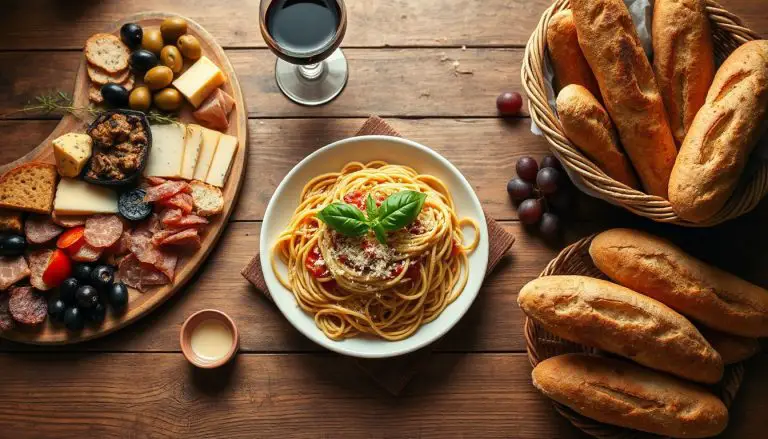
Discovering Tunisia’s Culinary Treasures: 6 Famous Dishes You Must Try
Imagine a place where the sun shines bright. Where the aroma of spices fills the air. Tunisian cuisine is a vibrant mix. Mediterranean, Berber, and Arab flavors blend. This creates a taste experience that’s unique. Tunisia, a North African gem, boasts a rich food heritage. Let’s explore six famous dishes. Each one tells a story. Prepare for a delicious journey!
Couscous: Tunisia’s National Dish
Couscous is more than just food. It’s a symbol of Tunisian culture. It’s a part of daily life. Families gather around to share this dish. It brings people together. It is a true national treasure.
History and Preparation of Tunisian Couscous
Couscous has ancient origins. Berbers first made it centuries ago. The process is traditional. Semolina wheat is steamed. A special pot called a couscoussier is used. This ensures the couscous is light and fluffy.
Regional Variations and Common Ingredients
Tunisian couscous varies by region. Some use fish in coastal areas. Others prefer lamb in the south. Vegetables are always a key component. Harissa, a spicy paste, adds a kick. Spices like cumin and coriander enhance the flavor.
How to Best Enjoy Couscous: Tips and Pairings
To best enjoy couscous, serve it hot. Pair it with a flavorful broth. Add a dollop of harissa for extra spice. A side of fresh salad complements the dish. You can try it with roasted vegetables too.
Tagine: A Slow-Cooked Symphony of Flavors
Tagine is a slow-cooked stew. It simmers until the flavors meld. This dish is very versatile. You can use many different ingredients. It’s a flavorful experience.
Understanding the Tagine: Ingredients and Cooking Techniques
Key ingredients in tagine include meat, vegetables, and spices. Chicken, lamb, or beef are common choices. Vegetables like carrots, potatoes, and zucchini are often added. Spices such as ginger, cinnamon, and saffron create depth. Slow cooking is essential. It allows the flavors to develop fully.
Popular Tunisian Tagine Variations
Popular variations include chicken with olives and lemons. Lamb with dried fruits and almonds is another favorite. These variations show the dish’s adaptability. Every cook adds his or her personal touch.
Serving and Pairing Suggestions for Tagine
Serve tagine hot. Offer it with crusty bread. The bread is perfect for soaking up the sauce. A fresh salad balances the richness. Mint tea is a refreshing drink to pair with it.
Brik: The Crispy, Savory Delight
Brik is a thin pastry. It’s filled with savory ingredients. Its crispy texture is delightful. It is a popular street food.
The Art of Making Brik: Dough and Fillings
The dough for brik is paper-thin. It requires skill to make. Common fillings include egg, tuna, and capers. Potatoes and parsley are also popular. The brik is fried until golden brown and crispy.
Regional Brik Variations and Unique Twists
Regional variations exist across Tunisia. Some add shrimp or seafood. Others include spicy sauces. Each region has its own twist on this classic.
Tips for Enjoying Brik: Freshness and Accompaniments
Enjoy brik fresh. It’s best when it’s hot and crispy. A squeeze of lemon enhances the flavor. Harissa adds a spicy kick. Eat it immediately for the best experience.
Lablabi: A Hearty Chickpea Soup
Lablabi is a popular chickpea soup. It’s a hearty and affordable meal. It’s often eaten for breakfast. It’s comforting and warm.
The Essence of Lablabi: Ingredients and Preparation
Key ingredients are chickpeas, garlic, and cumin. Olive oil adds richness. The chickpeas are cooked until tender. The soup is then seasoned with spices.
Customizing Your Lablabi: Toppings and Variations
You can customize your lablabi. Add a soft-boiled egg. Include tuna or olives. A spoonful of harissa adds heat. These toppings make it your own.
Why Lablabi is a Tunisian Staple: Cultural Significance
Lablabi is a comfort food in Tunisia. It’s a staple in many households. It’s often eaten on cold days. It provides warmth and nourishment.
Harissa: Tunisia’s Fiery Paste
Harissa is a staple ingredient in Tunisia. It adds heat and flavor to many dishes. It’s a versatile paste. It is a must-have in every kitchen.
What Makes Harissa Unique: Ingredients and Production
Harissa is made from chili peppers, garlic, and spices. Cumin and coriander are key ingredients. The peppers are dried and ground. The ingredients are blended into a paste.
Using Harissa in Tunisian Dishes
Harissa is used in couscous and tagine. It flavors soups and sandwiches. You can try it in Brik. It adds a spicy kick to almost anything.
Buying and Storing Harissa: Tips for Freshness
Buy harissa from reputable sources. Store it in the refrigerator. Use a clean spoon to prevent contamination. You can also make your own homemade harissa.
Tunisian Salad: A Refreshing Mediterranean Delight
Tunisian Salad is a refreshing option. It’s healthy and easy to prepare. Fresh ingredients make it delicious. It is perfect for a light meal.
Fresh Ingredients and Preparation Methods
Main ingredients include tomatoes, cucumbers, and peppers. Onions and olives are also added. The vegetables are diced and mixed. A simple dressing of olive oil and lemon juice is used.
Variations and Regional Twists
Some variations include tuna or egg. Others add herbs like mint or parsley. Each region has its unique twist.
Serving Suggestions and Health Benefits
Serve Tunisian Salad as a side dish or appetizer. It’s a great source of vitamins and fiber. It’s also low in calories. This salad is a healthy choice.
Conclusion
We’ve explored six famous Tunisian dishes. Each one offers a unique taste. These dishes reflect Tunisia’s rich heritage. We encourage you to try them. Experience the flavors of Tunisia yourself. Discover the culinary treasures of this amazing country.







